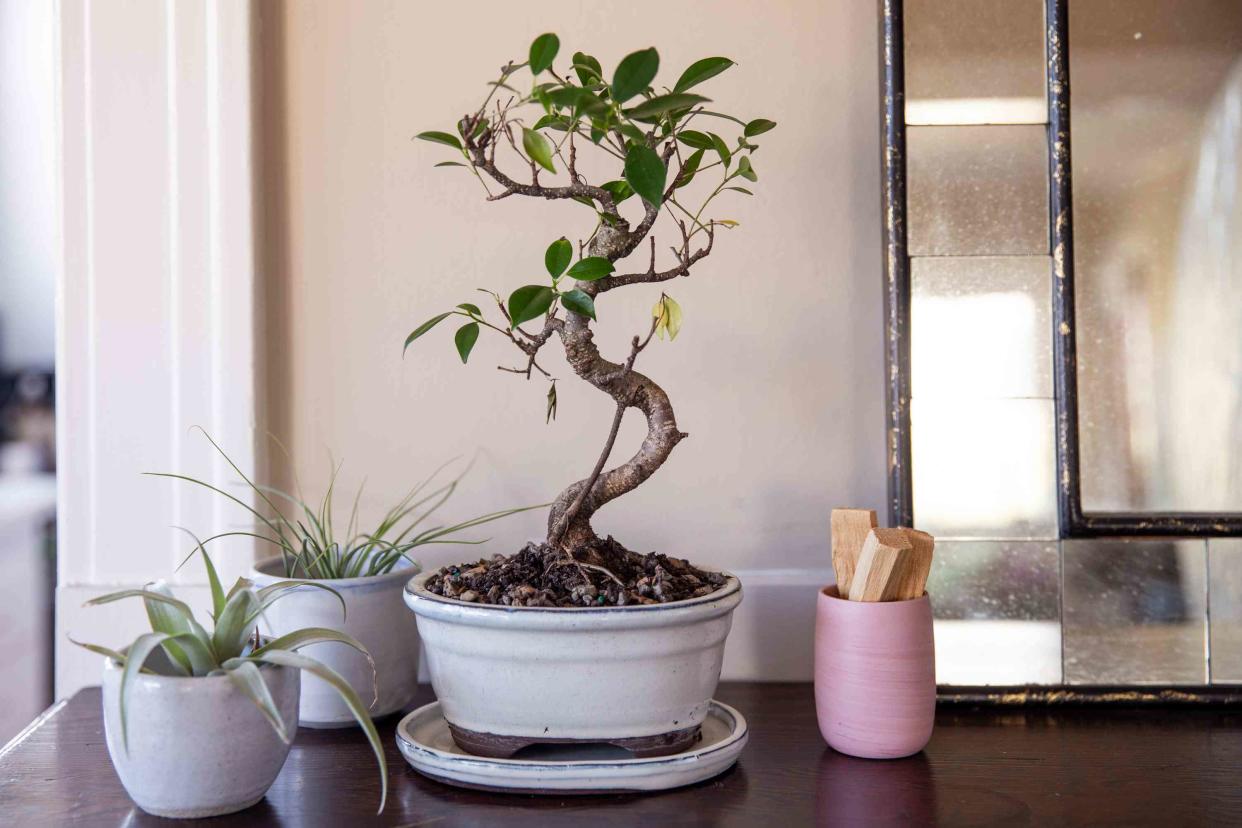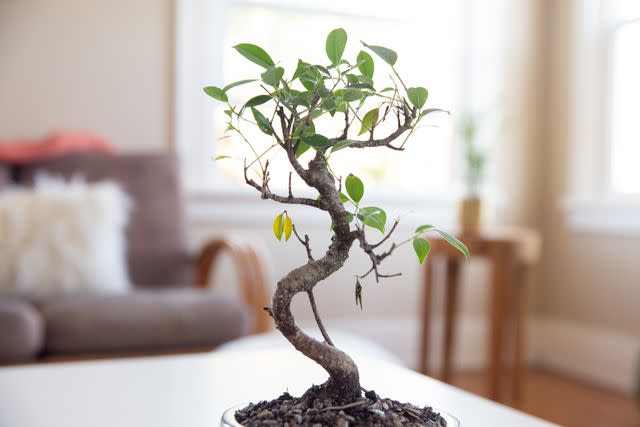How to Grow and Care for a Bonsai Tree

The Spruce / Krystal Slagle
Bonsai trees have a reputation for being extremely delicate and difficult to maintain. Their special needs arise from the importance of recreating their parent tree's ideal conditions, which may include certain levels of light, humidity, or soil nutrition important for vibrancy and longevity. While these specimens do require special attention, once you learn the principles of bonsai care, it's fairly straightforward.
Fun Facts
Bonsai is a Japanese word that literally means "planted in a container". It refers to the practice of keeping large plant specimens, usually trees, from reaching their natural size by a process referred to as "artificial dwarfing."

The Spruce / Krystal Slagle

The Spruce / Krystal Slagle
Bonsai Tree Selection
Selecting the right bonsai for your situation is important to ensure you can care for it effectively. There are easy, low-care bonsai varieties such as ficus and jade. You can choose a deciduous, sub-tropical or tropical bonsai tree, and read up on the different specific ways to take care of it.
Consider your local conditions too. Is your backyard naturally sunny in winter? That might be a plus for a deciduous bonsai specimen. Do you hot and humid summers? Then a sub-tropical tree should do fine for you. Do you have a sunny bay window that gets bright light on a winter afternoon? Then you can grow a tropical bonsai tree that you can bring indoors for the winter.
A bonsai is not just meant to survive but to flourish with beauty. It's not just a plant but a work of art. With that in mind, here are some tips for caring for your bonsai.
Indoors or Outdoors?
If your bonsai is a deciduous tree, it will benefit from being outdoors, in order to be exposed to the natural weather conditions it is suited to. If a deciduous tree is kept indoors (even a miniature one) it won't get the exposure to cold necessary for its season of dormancy in winter. This is an important part of the tree's growth cycle.
Your bonsai tree will also benefit from the gradual increased exposure to sunlight that occurs naturally with the seasons. With that in mind, you will still want to protect your bonsai from extreme weather conditions or possible damage. So, if there's a storm in the forecast, shelter your bonsai from the wind, heavy rain or snow by placing in under an awning, or bring it indoors for the duration of the bad weather conditions.
It is possible to grow a deciduous bonsai indoors year-round, but it will benefit from a natural light source and plenty of fresh air, so placing it in a sunny window is the best location.
If your bonsai is a tropical plant, but you live in a growing zone that gets cold winters, you will have to move your indoors for a few months until the danger of frost has passed. You'll also need to be very careful to make sure your bonsai gets adequate moisture and humidity, which can be adversely affected by indoor heating systems.
Bonsai Tree Care
Bonsai can do very well indoors or outdoors on a year-round basis if you make sure its essential needs are met.
Make sure your bonsai tree receives enough direct natural light.
Give your bonsai a little outing from time to time if kept indoors. This will give it fresh air, a light mist of raindrops, or some dappled sunlight.
Monitor your tree constantly to gauge how much water it needs and how often.
Keep the soil rich in nutrients and make sure it's draining properly.
Fertilize a minimum of once yearly especially if the tree is young.
Light
Whether your bonsai lives inside or outside, it must receive enough natural light to thrive. If you need to bring your tree indoors for the winter, make sure it gets enough natural light. Even in winter, when there are fewer hours of daylight, the intensity of sunlight is much brighter outside than it is inside. The best thing is a sunny window that gets several hours of daylight.
Soil
Choice of soil is crucial to the health of your bonsai tree. Since the roots live in a compact container, space is limited. The soil should be a rich mix of nutrients with enough aeration and drainage. The best soil will include inorganic material for drainage and air pockets and organic material to retain nutrients and water.
Water
Watering as needed is better for your bonsai than watering on a set schedule. This is especially important for indoor bonsai as it helps mimic outdoor weather conditions. Traditionally bonsai are kept in small pots without much room for soil nutrients or moisture retention. Constant monitoring and appropriate watering or misting is important. You're essentially creating a microclimate for your bonsai.
Temperature and Humidity
If your bonsai is tropical or sub-tropical and you're keeping indoors, avoid a drafty window, as the cold may injure the foliage. If your bonsai is native to colder climates and kept outdoors, these lower temperatures will enable them to enter dormancy, an essential stage to maintaining its health.
One of the trickiest parts of caring for bonsai is getting the humidity level in its environment just right. One good way to make sure your indoor bonsai gets adequate humidity is to place a shallow dish of water nearby. Opening a window to let in the fresh air also helps humidity levels.
Fertilizer
Bonsai trees should be fed on a regular basis since there's limited space for nourishing soil. Species kept outdoors can be fertilized weekly during their growing season, but if your bonsai is subtropical, it's in a constant state of growth and should be fed throughout the year.
Choose a fertilizer rich in nitrogen, phosphorus, and potassium to strengthen roots and encourage growth. Depending on the species, a bonsai fertilizer is often made for that specific type of tree.
Types of Bonsai Tree
Many different species of trees are used for growing bonsai. Here are a few of the most popular types:
Japanese Maple (Acer Palmatum): This deciduous tree has leaves that turn bright red and orange in the fall and bark that turns grayish-brown as it matures. This type requires generous watering as much as multiple times per day.
Cedar (Cedar spp.): Multiple species of cedar are grown as bonsai. These evergreens have short needle clusters along their branches and rough bark.
Weeping Fig (Ficus Benjamina): This hardy bonsai is good for beginners. With an umbrella-like canopy of leaves and twisted roots it thrives as a houseplant all year long.
Pruning
Proper pruning is important to maintain the tree's shape and encourage flowering and fruiting at the right time. Prune most bonsai trees in early spring or late fall. This can be species-specific, so check on the recommended care of your particular tree. Shaping a bonsai involves first cutting off any dead branches or foliage, as well as those growing at odd angles from the tree trunk. Shape the remaining branches using wires of necessary aiming to have the thicker branches towards the roots and thinner branches towards the top of the trunk.
Potting and Repotting Bonsai
Choose a pot for your bonsai that is small enough that your tree will appear large. This mimics the proportions of the full-sized tree in nature. Check for drainage holes as root rot can be an issue if sitting in soggy soil too long. Some pots made for bonsai also have wiring holes to help anchor the plant as it's being shaped.
It is important to repot a younger bonsai tree once per year and a mature tree every three years. Winter is the ideal season for this. Since bonsai trees grow in small containers, they are susceptible to becoming root-bound and taking up too much of the soil over time. New roots will form, and older roots can be trimmed away during repotting. It's not necessary to go into a larger pot. The main goal is to replace the soil not container.
Common Pests & Plant Diseases
Even the healthiest bonsai tree can face a pest infestation or plant disease. Bonsai trees can be attacked by aphids, spider mites, and mealybugs, among others. Additionally, root rot can develop if there is poor drainage and over-watering. Canker disease can occur due to an excess of nitrogen in the fertilizer or a wound caused by pruning. Therefore, it is essential to take great care in all aspects of maintaining your bonsai.
Common Problems with Bonsai Trees
Brown Spots on Undersides
Rust is a fungal disease that can cause reddish-orange or brown spots on the undersides of the foliage of a bonsai. It will eventually cause the leaves to drop. It's important to remove any infected areas as quickly as possible and treat the remaining areas with a fungicide.
Leaves Turning Yellow
If your leaves are taking on a yellowish tone, this could be a sign of a soil deficiency. Chlorosis results from a lack of magnesium or iron in the soil. When the tree can't produce enough chlorophyll, it weakens the foliage and the tree overall. Make sure you're applying enough of a nutrient-rich fertilizer to prevent this.
White Spots on Branches
Any white patches on the branches or film indicate powdery mildew, a type of fungal infection. If there's a lack of air circulation in the tree's environment and a rise in humidity, powdery mildew can spread quickly on both branches and leaves. Prune off affected leaves and apply a fungicide to all areas of the tree before it weakens as a result.
Frequently Asked Questions
How long can a bonsai tree live?
The lifespan of a bonsai tree is determined by many variables, including species, maintenance, habitat, and even the age of the mother tree. Some bonsai can live up to 50 years when cared for properly. Some bonsai trees in the world are estimated to be several hundred years old.
What's the difference between a bonsai tree and a dwarf tree?
Many gardeners are familiar with the concept of dwarf specimens of trees or shrubs. For example, semi-dwarf or dwarf fruit trees are bred to grow to between 1/3 to 1/2 their normal size. Such trees can be very useful for orchard fruit production and urban growing in small spaces.
But bonsai are not really dwarves. Instead, they are like a miniature version of a tree that is trained, pruned and maintained in a way that makes it look like a much smaller version of its full size.
What is the best bonsai tree for beginners?
If you're just planning to start growing Bonsai, it's recommended that you choose a tree species that is suitable for the location where you'll keep it. Ficus Bonsai is an excellent option for growing indoors, while Juniper Bonsai is perfect for outdoor growth. Both species are tough and durable and great for beginner bonsai gardeners.
Read the original article on The Spruce.

